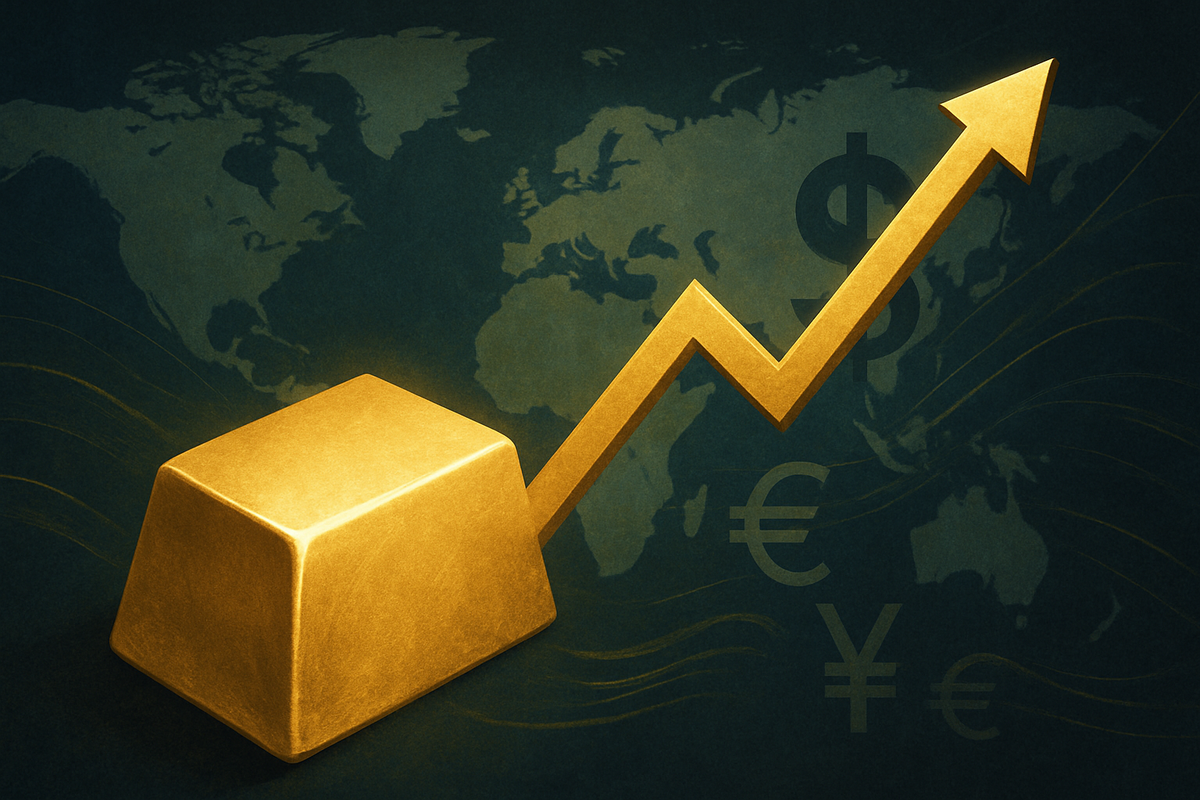
Experts are increasingly converging on the view that gold's recent impressive surge is more than a fleeting market phenomenon, with fundamental drivers suggesting its staying power. This bullish outlook is set against the backdrop of a simmering, yet increasingly significant, debate regarding the long-term dominance of the US dollar as the world's primary reserve currency. The confluence of these factors—gold's renewed strength and the questioning of dollar hegemony—is recalibrating the role of precious metals as indispensable safe-haven assets in an uncertain global financial landscape.
The immediate implications are profound for investors and policymakers alike. As geopolitical tensions escalate, inflation concerns persist, and central banks globally diversify their reserves, gold's appeal as a store of value and a hedge against instability is amplified. The potential for a weaker dollar further enhances gold's attractiveness, making it more accessible to international buyers and cementing its position as a critical component in portfolios seeking resilience against economic and political shocks.
The Golden Tide: Drivers and Dollar Dynamics
The current gold rally, which has seen prices reach significant highs, is underpinned by a robust set of drivers that analysts believe will sustain its momentum well into the future. Major financial institutions such as J.P. Morgan, Deutsche Bank, Goldman Sachs, and UBS have issued optimistic forecasts, with some projecting gold prices to potentially hit $4,000 per ounce by mid-2026. This confidence stems from several key factors: persistent geopolitical tensions and economic uncertainties, including ongoing global conflicts and trade disputes, which historically drive investors towards safe havens. Gold's traditional role as an inflation hedge also remains a powerful draw, as concerns about persistent inflationary pressures continue to loom despite central bank efforts.
A significant catalyst for gold's strength is the anticipated weakening of the US dollar. As the dollar softens, gold becomes more affordable for international buyers, stimulating global demand. Furthermore, the aggressive buying spree by global central banks, diversifying their reserves away from fiat currencies, provides substantial, structural support for gold prices that is expected to continue for years. The expectation of further interest rate cuts by the Federal Reserve also plays a crucial role; lower rates reduce the opportunity cost of holding non-yielding assets like gold, making it more appealing compared to interest-bearing alternatives. Negative real interest rates, where inflation outpaces nominal rates, are particularly conducive to gold's performance.
Simultaneously, the long-standing hegemony of the US dollar, which has been the world's dominant reserve currency since the 1940s, is facing increasing scrutiny. This "de-dollarization" debate is primarily fueled by geopolitical shifts and evolving economic landscapes. While the dollar remains deeply entrenched in the global system, accounting for a majority of global foreign currency reserves, debt, and international payments, its share of global reserves has seen a gradual decline over the past two decades. Arguments for continued dollar dominance highlight its unparalleled liquidity, the stability of the US economy, and the lack of a truly viable alternative. However, the assertive use of US sanctions as a foreign policy tool, particularly in the wake of events like the Russo-Ukraine War, has spurred countries, especially within the BRICS bloc, to actively seek alternatives and reduce their dollar dependency, leading to increased gold acquisitions and the promotion of local currency trade.
This ongoing debate about dollar dominance is not merely theoretical; it has tangible implications for precious metals. The very factors that challenge the dollar's supremacy—geopolitical fragmentation, economic instability, and concerns over currency devaluation—reinforce gold's traditional role as a safe haven. Central bank efforts to diversify away from the dollar directly translate into increased gold purchases, providing a robust, long-term driver for gold prices. As confidence in traditional fiat currencies wavers, gold stands out as an attractive alternative, prompting both institutional and private investors to increase their allocation to precious metals for portfolio diversification and protection against systemic risks.
Corporate Fortunes: Winners and Losers in a Shifting Landscape
A sustained gold surge and the ongoing debate surrounding dollar dominance are poised to create distinct winners and losers among public companies, fundamentally altering their revenue streams, cost structures, and market positions. At the forefront of the beneficiaries are gold mining companies, which stand to gain directly from higher gold prices. Firms like Barrick Gold (NYSE: GOLD) and Newmont Corporation (NYSE: NEM) will see their revenues swell and profit margins expand significantly, assuming production costs remain manageable. Increased cash flows will enable these companies to reduce debt, invest in new exploration and development projects, and potentially return more capital to shareholders. The sector, encompassing smaller producers like Agnico Eagle Mines (NYSE: AEM) and junior explorers, could experience a renaissance as previously marginal deposits become economically viable.
Precious metals refiners, while benefiting from increased activity, face a more nuanced impact. Companies such as Hecla Mining Company (NYSE: HL), which also refines silver, could see higher processing volumes driven by increased mining output and investor demand. Their profitability, however, largely depends on refining fees, which are either a percentage of the metal's value or a fixed charge. A sustained gold surge would likely increase the value of the metal they handle, potentially boosting overall operational activity and revenues, especially for efficient, high-volume refiners.
Financial institutions will experience a mixed bag of effects. Those specializing in precious metals, such as providers of gold-backed Exchange Traded Funds (ETFs) like SPDR Gold Shares (NYSEARCA: GLD), are likely to see increased inflows and assets under management, leading to higher fee revenues. Banks with active precious metals trading desks could also benefit from heightened trading volumes and volatility. Conversely, institutions with significant exposure to US dollar-denominated assets or those heavily invested in broader market equities and bonds might face challenges if capital shifts into gold, leading to potential underperformance of their traditional portfolios and increased demands on risk management. A broad depreciation of US financial assets, driven by de-dollarization, could lead to upward pressure on real yields and impact institutions with large holdings in US Treasuries.
Companies heavily reliant on international trade, particularly those outside the US, will also be significantly affected by a shift in dollar dominance. A weaker US dollar would make American goods more competitive globally, potentially boosting US exporters. Conversely, US importers would face higher costs for foreign goods. For non-US companies, especially those with substantial dollar-denominated debt, a weaker dollar would ease their debt servicing burden, improving balance sheets. Companies that can adapt their invoicing and financing to a more multipolar currency system, or those in countries actively pursuing de-dollarization, could gain a strategic advantage. However, companies like FedEx (NYSE: FDX) and UPS (NYSE: UPS), while not directly impacted by gold, could see reduced shipping volumes if economic uncertainty and trade fragmentation, often associated with these shifts, lead to a slowdown in global trade.
Global Repercussions: A Redefinition of Financial Stability
The sustained surge in gold prices and the escalating debate over the US dollar's dominance are not isolated events but rather powerful reflections of deeper, ongoing transformations in the global financial landscape. These phenomena align with broader industry trends toward de-globalization, increased geopolitical fragmentation, and a growing skepticism toward traditional fiat currencies. As international conflicts (such as the Russia-Ukraine war and Middle East tensions) and trade uncertainties persist, the flight to gold as the "ultimate safe haven" intensifies, underscoring a fundamental reassessment of risk and value in the global economy. This trend also highlights the strategic diversification efforts by central banks worldwide, which are steadily increasing their gold reserves as a hedge against currency devaluation and an explicit move away from an over-reliance on the US dollar.
The potential ripple effects of these shifts are far-reaching. For the US, a significant erosion of dollar dominance could lead to higher borrowing costs for its government and consumers, a potential loss of purchasing power, and a diminished geopolitical leverage, as the efficacy of its financial sanctions would be reduced. Conversely, a weaker dollar could make US exports more competitive but simultaneously increase the cost of imports, potentially exacerbating inflationary pressures. For nations holding substantial US dollar reserves, a depreciating dollar would mean a loss of purchasing power, further incentivizing their diversification into other assets, including gold and alternative currencies. This could accelerate the development of non-dollar payment systems and trade blocs, leading to a more complex and fragmented global economic architecture where the dollar shares its dominance with a basket of other currencies.
Regulatory and policy implications are profound. Central banks globally may need to recalibrate their monetary policies. If the gold rally is a symptom of persistent inflation fears or economic contraction, central banks might be pressured to implement more aggressive monetary easing, risking further currency debasement. Conversely, if a weakening dollar fuels domestic inflation, central banks could face pressure to tighten monetary policy. Fiscal discipline also becomes paramount; events like the US government shutdown, which can heighten investor anxiety, underscore the need for greater political consensus to prevent disruptive economic events. Furthermore, producing nations, particularly in regions like West Africa, are already reassessing mining royalties to capture more value from soaring gold prices, often shifting to progressive royalty structures.
Historically, periods of gold surges and challenges to currency dominance are not unprecedented. The 1970s, marked by oil shocks, rampant inflation, and the collapse of the Bretton Woods system, saw gold prices skyrocket, demonstrating its role as an inflation hedge during times of monetary upheaval. Similarly, the post-2008 financial crisis and the COVID-19 pandemic triggered significant gold rallies as investors sought refuge from market turmoil and unconventional monetary policies. The decline of the British pound over the 20th century serves as a powerful historical precedent for a dominant currency losing its preeminent status. The current environment, characterized by a "perfect storm" of high inflation, persistent geopolitical conflicts, and unprecedented fiscal and monetary interventions, bears striking resemblances to these past events, suggesting a long-term recalibration of global financial power dynamics.
The Road Ahead: A Multipolar Financial Future
The current trajectory of a sustained gold surge and the ongoing re-evaluation of dollar dominance points to a future global financial system that is likely more diversified and multipolar. In the short term, the bullish momentum for gold is expected to persist, especially if geopolitical tensions remain elevated or if economic uncertainties, such as a prolonged US government shutdown, continue to fuel investor anxiety. This environment will likely see continued flight to gold as a safe haven, further reinforcing its role as a hedge against inflation and currency debasement. For nations, strategic pivots will involve accelerated reserve diversification away from the US dollar and into gold, as evidenced by aggressive central bank purchases, particularly from emerging markets. Companies will need to adapt their hedging strategies to account for increased currency volatility and focus on building more resilient and diversified supply chains.
Looking further ahead, the long-term possibilities suggest a permanent recalibration of gold's perceived value and an increased allocation within institutional and retail portfolios. Gold is increasingly being recast as a fundamental component of a multi-asset reserve system in a multipolar world, offering political neutrality and no counterparty risk. Forecasts suggest gold could reach $4,200-$4,800 per ounce by 2027-2028, and potentially higher in the coming decades, solidifying its role as a core asset in a world characterized by geopolitical fragmentation and a desire for greater financial autonomy. This sustained gold accumulation by central banks signals an acceleration of de-dollarization, not necessarily as a sudden collapse, but as a gradual erosion of the dollar's dominance.
Market opportunities will emerge for investors in physical gold, gold ETFs, and gold mining equities, capitalizing on persistent safe-haven demand and a favorable monetary environment. The mining sector is likely to see increased investment in exploration and development as higher prices make more projects economically viable. However, challenges include potential short-term volatility, the opportunity cost of holding a non-yielding asset, and the need for companies using gold in technology and manufacturing to contend with rising raw material costs. For the global financial system, the most likely scenario is a gradual shift to a multipolar reserve system, where the US dollar's share of global reserves continues to decline, and other currencies like the euro and yuan play increasingly important roles, with gold providing a neutral common denominator for international settlements. This evolution will redefine how capital moves across borders, with the rise of tokenized assets and central bank digital currencies (CBDCs) potentially fostering greater adaptability and resilience.
Navigating the New Financial Frontier: Investor Outlook
The sustained surge in gold prices and the ongoing, intensifying debate about the US dollar's dominance represent more than just market movements; they are profound indicators of a global financial system in flux. Key takeaways from this period include gold's undeniable re-establishment as a premier safe-haven asset, driven by persistent geopolitical turmoil, pervasive inflation concerns, and a strategic, aggressive accumulation by central banks worldwide. This central bank buying, in particular, signals a deliberate diversification away from dollar-denominated assets, reflecting a desire for greater financial autonomy and a hedge against potential "sanctions risk." While the US dollar retains significant structural advantages, its diminishing share in global reserves and the emergence of alternative payment systems underscore a gradual, yet significant, shift towards a more multipolar currency environment.
Moving forward, the market is poised for continued volatility and structural adjustments. The outlook for gold remains bullish for the medium to long term, with analysts forecasting further price appreciation, potentially reaching $4,000 per ounce by mid-2026 and even higher in subsequent years. This trajectory is supported by the structural demand from central banks, ongoing global risks, and the expectation of lower interest rates. The US dollar, while not facing an imminent dethroning, is likely to experience continued pressure, influenced by Federal Reserve policy, inflation data, and geopolitical developments. The lasting impact of these trends will be a global financial system that is more diversified, potentially more fragmented, and one where hard assets like gold play an increasingly central role in maintaining stability and trust.
For investors in the coming months, vigilance and strategic diversification are paramount. Gold should be considered a crucial portfolio diversifier, with allocations of 5-10% often recommended to enhance risk-adjusted returns, accessible through physical gold, ETFs, or reputable gold mining stocks. It is vital to closely monitor central bank policies, especially Federal Reserve interest rate decisions, as these significantly influence both gold prices and the dollar's trajectory. Tracking geopolitical developments, assessing US economic data for signs of slowing growth or persistent inflation, and diversifying currency exposure beyond purely dollar-denominated assets are all critical steps. Adopting a long-term perspective is key, as these are structural shifts rather than transient market fluctuations, demanding a thoughtful and adaptive investment approach.
This content is intended for informational purposes only and is not financial advice





